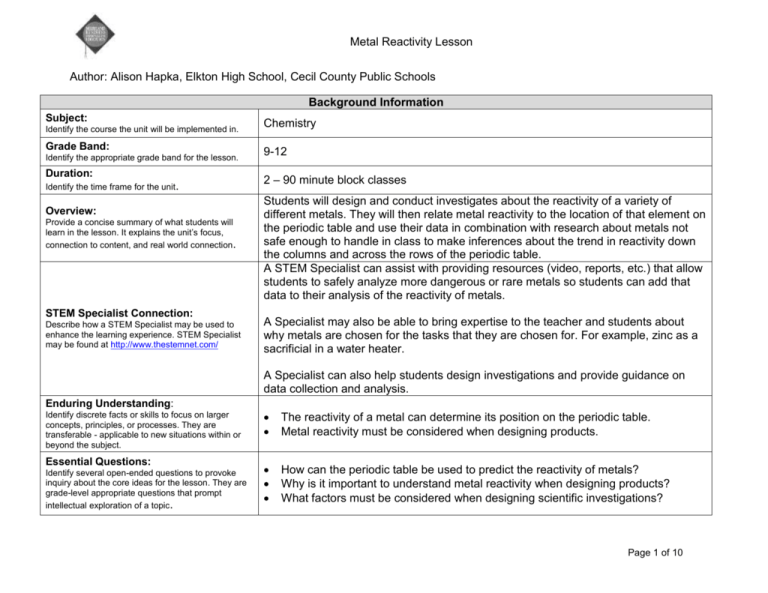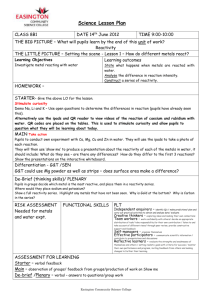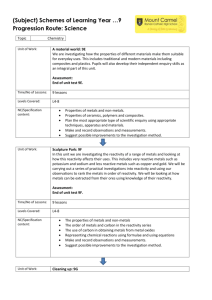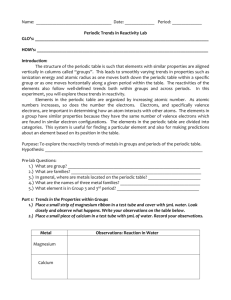Metal Reactivity Lesson
advertisement

Metal Reactivity Lesson Author: Alison Hapka, Elkton High School, Cecil County Public Schools Background Information Subject: Identify the course the unit will be implemented in. Grade Band: Identify the appropriate grade band for the lesson. Duration: Identify the time frame for the unit. Overview: Provide a concise summary of what students will learn in the lesson. It explains the unit’s focus, connection to content, and real world connection. STEM Specialist Connection: Describe how a STEM Specialist may be used to enhance the learning experience. STEM Specialist may be found at http://www.thestemnet.com/ Chemistry 9-12 2 – 90 minute block classes Students will design and conduct investigates about the reactivity of a variety of different metals. They will then relate metal reactivity to the location of that element on the periodic table and use their data in combination with research about metals not safe enough to handle in class to make inferences about the trend in reactivity down the columns and across the rows of the periodic table. A STEM Specialist can assist with providing resources (video, reports, etc.) that allow students to safely analyze more dangerous or rare metals so students can add that data to their analysis of the reactivity of metals. A Specialist may also be able to bring expertise to the teacher and students about why metals are chosen for the tasks that they are chosen for. For example, zinc as a sacrificial in a water heater. A Specialist can also help students design investigations and provide guidance on data collection and analysis. Enduring Understanding: Identify discrete facts or skills to focus on larger concepts, principles, or processes. They are transferable - applicable to new situations within or beyond the subject. The reactivity of a metal can determine its position on the periodic table. Metal reactivity must be considered when designing products. Essential Questions: How can the periodic table be used to predict the reactivity of metals? Why is it important to understand metal reactivity when designing products? What factors must be considered when designing scientific investigations? Identify several open-ended questions to provoke inquiry about the core ideas for the lesson. They are grade-level appropriate questions that prompt intellectual exploration of a topic. Page 1 of 10 Metal Reactivity Lesson Background Information Students will be able to: Student Outcomes: Identify the transferable knowledge and skills that design and conduct an investigation to rank the reactivity of a list of metallic students should understand and be able to do when elements from most reactive with acid to least reactive with acid and with the lesson is completed. Outcomes must align with water. but not limited to Maryland State Curriculum and/or national standards. examine how the workforce use metal reactivity in product designs. Audience: ☒Peers ☒Experts / Product, Process, Action, Performance, Students will plan and conduct an experiment that test the etc.: Practitioners reactivity of alkali metals and rank metals from least to most Identify what students will produce to reactive. They will then examine how workplace professionals use ☒Teacher(s) demonstrate that they have met the challenge, metal reactivity to improve the function of different products. ☐School learned content, and employed 21st century Community skills. Additionally, identify the audience they will Lastly, students will produce a lab report detailing their experimental procedures, data, and conclusions. present what they have produced to. ☐Online Community ☐Other______ Next Generation Science Standards: HS-PS1 Matter and its Interactions HS-PS1-1 Use the periodic table as a model to predict the relative properties of elements based on the patterns of electrons in the outermost energy level of atoms. Standards Addressed in the Unit: Identify the Maryland State College and Career Ready Standards addressed in the unit. Common Core Reading in Science and Technical Subjects: RST.11-12.3 Follow precisely a complex multistep procedure when carrying out experiments, taking measurements, or performing technical tasks; analyze the specific results based on explanations in the text. Common Core Writing in Science and Technical Subjects: WHST.11-2.2 Write informative/explanatory texts, including the narration of historical events, scientific procedures/experiments, or technical processes. Page 2 of 10 Metal Reactivity Lesson Background Information Suggested Materials and Resources: Identify materials needed to complete the unit. This includes but is not limited to websites, equipment, PowerPoints, rubrics, worksheets, and answer keys. Equipment: samples of metallic elements, spot plates, Hydrochloric acid (precise concentration is not important, a concentration of 0.1 M – 0.5 M is appropriate), safety goggles, lab aprons, infrared thermometers, pipettes, small beakers to dispense the acid, sandpaper, distilled water, and internet access. Suggested Websites: Reactivity of Sodium and Potassium Video: https://www.youtube.com/watch?v=uixxJtJPVXk Reactivity of Alkali Metals Video: https://www.youtube.com/watch?v=m55kgyApYrY How to maintain a lab notebook: http://web.mit.edu/me-ugoffice/communication/labnotebooks.pdf People, Facilities: STEM Specialist Materials (rubrics, worksheets, PowerPoints, answer keys, etc.): Lab Report Template Page 3 of 10 Metal Reactivity Lesson Learning Experience 5E Component Identify the 5E component addressed for the learning experience. The 5E model is not linear. ☒Engagement ☐Exploration Details Materials: Video projector and internet access. Reactivity of Alkali Metals Video: https://www.youtube.com/watch?v=m55kgyApYrY ☐Evaluation ☒Asking questions (for science) and defining problems (for engineering) ☐Developing and using models ☐Explanation ☐Extension Science and Engineering Practices Facilitation of Learning Experience: Have students look at the periodic table. Ask students to identify which elements on the periodic table are metals and which are nonmetals. Review locations of metals and non-metals with class if needed. Ask students to write a prediction of what happens when an alkali earth metal is added to either the acid or the water. Have students discuss their predictions. After students have had time to discuss prediction, show the Reactivity of Alkali Metals video and have students record the observations for each reactions. Transition: Review the lab safety rules for using acid in the classroom and remind students that no hats or head wear can be worn during the laboratory investigation. When using acid, students must wear chemical splash goggles at all times as well as a lab apron. If any acid is spilled during the lab, the student is to step back from the spill and say “spill” then wait until the teacher can evaluate the spill and clean up the area before resuming lab work. If anyone spills acid on their skin, the area is to be thoroughly cleaned with soap and water immediately and the teacher notified of the skin contact. ☐Planning and carrying out investigations ☐Analyzing and interpreting data ☐Using mathematics and computational thinking ☒Constructing explanations (for science) and designing solutions (for engineering) ☐Engaging in argument from evidence ☒Obtaining, evaluating, and communicating information Page 4 of 10 Metal Reactivity Lesson Learning Experience 5E Component Identify the 5E component addressed for the learning experience. The 5E model is not linear. ☐Engagement ☒Exploration ☐Explanation ☐Extension ☐Evaluation Details Materials: Sample of Elemental Metallic Chunks Spot Plate Sand Paper Hydrochloric Acid Pipettes Beakers Safety Goggles Long Pants Closed Toe Shoes Preparation: Have acid of an appropriate concentration (a concentration of 0.1 M – 0.5 M) prepared prior to having the students start the experiment. Facilitation of Learning Experience: Inform students that they will be ranking metals from the video and lab from the most reactive in acid to the least reactive in acid. Emphasize the importance of carefully sanding each metal sample to prepare the surface for a possible reaction. It is important to allow students to determine how to best organize their data collection in their laboratory notebooks, and how to organize their approach to the lab so that they know when they have completed all of the necessary tests. If a group is struggling with organization, they can be asked questions such as: How many times do you think you should repeat each test? Is it easy to tell by looking at your lab notebook whether or not you have finished collecting all the data for the experiment? Science and Engineering Practices ☒Asking questions (for science) and defining problems (for engineering) ☐Developing and using models ☒Planning and carrying out investigations ☒Analyzing and interpreting data ☐Using mathematics and computational thinking ☐Constructing explanations (for science) and designing solutions (for engineering) ☐Engaging in argument from evidence ☒Obtaining, evaluating, and communicating information Page 5 of 10 Metal Reactivity Lesson Learning Experience 5E Component Identify the 5E component addressed for the learning experience. The 5E model is not linear. Details Science and Engineering Practices Are you recording what procedure you are following during the investigation? If you refer back to your lab notebook in a month, will you be able to tell what you did, what you observed, and what you were able to conclude from that data? Transition: Students are to check to make sure that the data they choose to collect during their experiment allows them to make a ranking supported by evidence from their investigation. ☐Engagement ☐Exploration ☒Explanation ☐Extension ☐Evaluation Materials: Computer with internet access. Preparation: Students need to have completed the reactivity of metallic elements investigation. Facilitation of Learning Experience: Once students are finished with the metal samples, they will put their data together in an organized table and work towards ranking the metals from the video and the lab investigation based on observational evidence. Transition: Ask students to share their rankings with the class by taping their final rankings to the classroom wall and have the class do a gallery walk of the rankings to see if they are the same or different. If all of the responses are ☐Asking questions (for science) and defining problems (for engineering) ☐Developing and using models ☐Planning and carrying out investigations ☒Analyzing and interpreting data ☐Using mathematics and computational thinking Page 6 of 10 Metal Reactivity Lesson Learning Experience 5E Component Identify the 5E component addressed for the learning experience. The 5E model is not linear. Details not identical, the whole class will work together to gather more evidence for one ranking or another until the group is certain of the ranking. Science and Engineering Practices ☐Constructing explanations (for science) and designing solutions (for engineering) ☐Engaging in argument from evidence ☒Obtaining, evaluating, and communicating information ☐Engagement ☐Exploration ☐Explanation ☒Extension ☐Evaluation Materials: STEM Specialist in materials science or metallurgy Computers with internet access ☐Asking questions (for science) and defining problems (for engineering) Preparation: Co-plan an engaging learning experience with a STEM Specialist that will allow students to understand how workplace professionals use different metals based on their reactivity. For example, pieces of zinc are used to avoid having a hot water tank rust out from too much corrosion. ☐Developing and using models Facilitation of Learning Experience: Engage students in the learning experience that was prepared with the STEM Specialist. As a closure to the learning experience, have students identify applications for each of the different metals that they investigated in lab or observed on the video clip. For each metal there should be one application with an explanation of why this metal is appropriate for this application based on the lab observations. ☐Analyzing and interpreting data ☐Planning and carrying out investigations ☐Using mathematics and computational thinking ☒Constructing explanations (for science) and designing solutions (for engineering) Page 7 of 10 Metal Reactivity Lesson Learning Experience 5E Component Identify the 5E component addressed for the learning experience. The 5E model is not linear. ☐Engagement Details Transition: Ask students to explain the trend in reactivity from the top to the bottom of the periodic table, and from the left to the right of the periodic table based on their lab data and video observations. ☐Engaging in argument from evidence Materials: Students will need their lab notebooks and experimental data. ☐Asking questions (for science) and defining problems (for engineering) Facilitation of Learning Experience: Students will write a lab report and submit it for grading. A sample lab report template can be found here >> Lab Report Template ☐Developing and using models ☐Exploration ☐Explanation ☐Extension ☒Evaluation Science and Engineering Practices ☒Obtaining, evaluating, and communicating information ☐Planning and carrying out investigations ☐Analyzing and interpreting data ☐Using mathematics and computational thinking ☐Constructing explanations (for science) and designing solutions (for engineering) ☐Engaging in argument from evidence ☒Obtaining, evaluating, and communicating information Page 8 of 10 Sample Lab Report Format Name (Name of lab partners), Date(s) Title of Formal Lab Report (Your title indicates both the problem under investigation and solution attempted.) Background Research This section describes similar past experiments, defines important vocabulary terms and explains the concepts involved in the investigation. Problem State the problem in the form of an accurate and specific question. The problem question includes the identification of both the independent and dependent variables. Hypothesis What was the hypothesis for your investigation? This is your prediction as to the answer of your problem question. Experimental Design Describe the details of the experimental design your group created to attempt to meet the desired outcome of the laboratory investigation. Include the materials used, procedure, and explanation of why those materials and that procedure were chosen to complete the investigation. The explanation must include a description of the physical meaning of each measurement described and how that measurement will help meet the desired outcome of the investigation. This is to be written in sufficient detail that another student can pick up the report and repeat the entire procedure exactly. A detailed sketch of the apparatus used in the investigation will be included in this section. Experimental Data, Observations, and Results Include a clearly labeled table of all of your experimental data, observations, and results with appropriate units. Data Analysis Describe the relationships that you observe between the different observations you made. Show all your work, tables, and graphs in this section including unit conversions. Discussion What are some sources of error? How could you have minimized your experimental error? Did the data and results yield a clear trend, or was the range of error too large to allow you to draw a clear conclusion? Experimental error is inherent in all investigations, it is not the same as mistakes such as human error. Conclusion Refer to your original problem question and hypothesis. State the relationship between the independent and dependent variable as supported by your data. What do the results of your investigation tell you? Remember to use appropriate scientific terminology and support your conclusion with your data. What is the physical meaning of your results? Was your hypothesis correct? Why or why not? Summarize and evaluate your experimental design and comment on its effectiveness and success. Questions for Further Research State three questions for further research that were raised by your experimental results. Suggest experimental investigations that can be completed to answer Page 9 of 10 Sample Lab Report Format each of your questions. Write the questions accurately and concisely indicating the dependent and independent variable in each. Application of Experimental Results to Practical Situations How can the results of your investigation be applied to two different practical situations? Describe each of these situations in a few sentences that clearly illustrate the direct connection between your results and the application you choose. Bibliography Use properly formatted citations for any references you used in the preparation of your report Page 10 of 10








